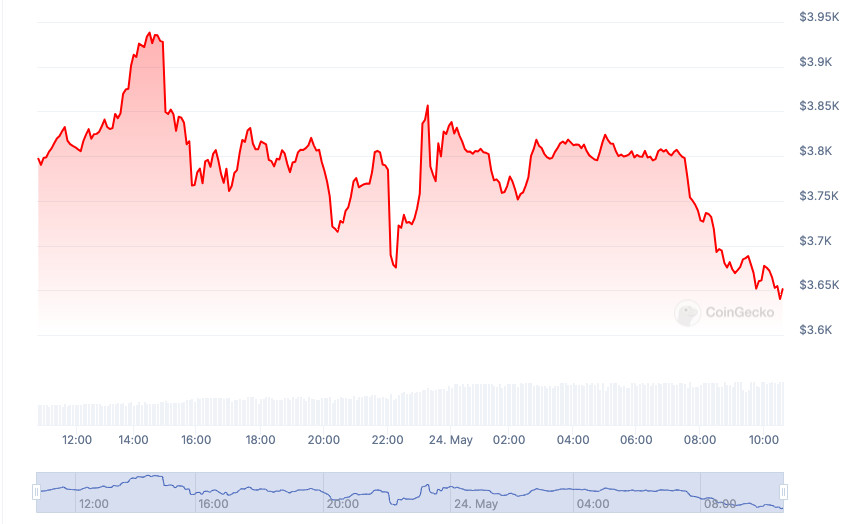ETH Faces Wild Volatility with Sharp Decline Following Lack of ETF Announcement Details


In Brief
The SEC has permitted the listing and trading of Ether ETFs on major U.S. exchanges, highlighting the complex nature of the SEC’s approach to cryptocurrency assets.
The listing and trading of spot Ether exchange-traded funds (ETFs) on major U.S. exchanges has been permitted by the SEC of the United States. The SEC’s approach to cryptocurrency assets is further demonstrated by this judgment, which is not as simple as it first appears. In this article, we will examine the SEC’s justification, discuss unresolved issues, and assess any possible ramifications for the cryptocurrency sector.
The SEC’s Analytical Framework
Preventing fraudulent and manipulative conduct was a primary focus of the SEC’s assessment, as required by Section 6(b)(5) of the Securities Exchange Act. In January 2024, the SEC underscored the significance of extensive surveillance-sharing arrangements with sizeable controlled sectors pertaining to the underlying asset based on its experience licensing spot Bitcoin ETFs.
However, the Chicago Mercantile Exchange (CME) does not actively monitor the spot Ether markets, despite the fact that the Ether market is regulated. This raised questions about how well the CME’s surveillance-sharing plan identified and deterred illicit activity in spot Ether trading.
Ether ETFs in 2024: The SEC’s Correlation Analysis
To address this problem, the SEC and the applicant exchanges conducted a thorough correlation study to see if price variations in the CME’s Ether futures market closely match those in the spot exchanges. Theft and manipulation in spot markets may be unintentionally identified by the CME’s surveillance if a significant relationship is discovered, as they have an impact on the price of the company’s Ether futures.
The SEC’s analysis, conducted over a 2.5-year period using hourly, five-minute, and one-minute data intervals, confirmed a consistently high correlation between the CME Ether futures sector and a subset of major spot Ether trading platforms, such as Coinbase and Kraken. This empirical evidence convinced the SEC that fraud or manipulation impacting spot Ether prices would likely have a similar impact on CME Ether futures prices, thus enabling the CME’s surveillance capabilities to assist in detecting such activities.
In the SEC document, Bitwise’s analysis of correlation data was also examined in detail. Let us remind you that in order to replicate the asset’s price performance without the overhead costs related to the fund’s management, Bitwise sought SEC clearance for its proposed Spot Ethereum ETF. When the characteristics of the Ethereum spot market and the CME Ethereum futures market were examined, the study showed no difference in the correlation values, indicating a high alignment between the two markets.
According to Bitwise, this disclosure allays regulatory worries about market manipulation and the reliability of the Ether market’s price discovery processes. The study’s findings, which give empirical proof that the Ether market acted in a way compatible with regulated financial markets, could have been extremely important in the SEC’s evaluation process.
Scott Johnsson mentioned that he had previously noted Bitwise Invest provided the most thorough correlation analysis. Johnsson added that the recent confirmation underscores the excellent job Bitwise Invest did, making them the issuer closest to the SEC numbers.
SEC Approach to Safeguarding Investors and Keeping Market Honesty
In addition to the investigation, the Securities Exchange Act’s Section 11A(a)(1)(C)(iii) required guarantees on the availability of information and the upkeep of fair and orderly markets, which is how the SEC assessed the offers.
The authorized Ether ETFs complied with these regulations by implementing measures like transparent portfolio holdings, well-defined surveillance methods, and trading halt restrictions. These steps strengthen investor safety and market integrity and are consistent with the SEC’s approach to other authorized ETPs.
Unanswered Questions After the SEC’s Decision Regarding ETF
Despite being a major step forward, the SEC’s clearance does not allay the worries expressed by commentators. The possible effects of combining traditional banking with cryptocurrency assets on the larger financial system are one important concern. Although the SEC was aware of these worries, it eventually decided that the plans complied with the Exchange Act.
However, the SEC’s response left this crucial issue largely unaddressed. The inherent volatility of crypto assets like Ether and the possible systemic risks associated with their integration into traditional finance warrant further examination and regulatory safeguards.
Additionally, the SEC’s decision did not provide a definitive stance on the nature of Ether itself. Some commenters argued that Ether’s decentralized nature and the Ethereum network’s consensus mechanism make it resistant to theft and manipulation, while others contended the opposite, citing centralization concerns and the potential for manipulation by a handful of validators and builders.
Effect of the Approval of Ether ETFs on the Crypto Market
The approval of spot Ether ETFs is poised to have far-reaching consequences for the whole sector and traditional finance alike. By paving the way for regulated investment vehicles that hold spot Ether, the SEC has taken a significant step towards integrating the second-largest cryptocurrency into mainstream financial markets.
This move could attract institutional investors and drive further adoption of Ether and the Ethereum network, potentially catalyzing the development of decentralized applications (dApps) and the broader Web3 ecosystem. However, it also raises questions about the long-term implications of such integration, particularly in terms of regulatory oversight and the potential for centralization.
According to the crypto research company Second Mountain, we can expect a massive capital inflow in the first week, potentially reaching billions. Grayscale’s ETHE Ethereum Trust alone holds approximately $9 billion worth of ETH (2.94 million ETH), which could readily convert to the ETF. This surge of investment would boost the Ethereum ecosystem, potentially pushing the prices of related altcoins higher.
According to HalogenCapital, Ether (ETH) has seen tremendous volatility since the introduction of ETFs; at the end of the day, it had dropped below $3,500 from a high of $3,950 in the morning session in New York. As of right now, there is no definitive date for when ETFs will be available for trading, which has dampened price fluctuations.
The latest ruling, nevertheless, raises the possibility that ETH’s price floor may be higher. While traditional institutions are still wary, demand has somewhat increased in the last day. With the increase in institutional interest, the price floor of ETH is anticipated to climb. However, there’s a chance that the listing procedure may drag on longer than expected, which would raise market leverage and perhaps cause liquidation events.

Photo: Ether price, 23-24 May, CoinGecko
Approval of Registration Statements
While the SEC’s approval of the 19b-4 filings is a milestone, it does not immediately greenlight the trading of spot Ether ETFs. The last step involves the SEC’s review and approval of each issuer’s S-1 registration statement, which provides comprehensive disclosures about the ETF’s financials, risk profile, and investment objectives.
Industry analysts suggest that this process could take days, weeks, or even months, leaving investors and market participants in anticipation. The SEC’s efficiency and timeliness in reviewing these registration statements will be closely watched, as any prolonged delays could dampen the enthusiasm surrounding this historic decision.
What Should We Expect Now From the ETH and Authorities?
The SEC’s approval of spot Ether ETFs is a watershed moment in the regulation of crypto assets, marking a significant shift in the agency’s approach. However, as this analysis has shown, the decision is not without nuances and lingering concerns.
A strong basis for the clearance is provided by the SEC’s correlation analysis and adherence to investor protection regulations. Nevertheless, there are still unanswered concerns about the underlying makeup of Ether, the possibility of future regulatory obstacles, and the systemic hazards of integrating cryptocurrency with traditional banking.
Although the clearance process for Ether ETFs has been a convoluted one, the SEC’s decision marks a noteworthy turning point. The tenets of a robust and long-lasting financial ecosystem—prudence, transparency, and a dedication to maintaining market integrity—must guide the crypto industry’s future developments.
Disclaimer
In line with the Trust Project guidelines, please note that the information provided on this page is not intended to be and should not be interpreted as legal, tax, investment, financial, or any other form of advice. It is important to only invest what you can afford to lose and to seek independent financial advice if you have any doubts. For further information, we suggest referring to the terms and conditions as well as the help and support pages provided by the issuer or advertiser. MetaversePost is committed to accurate, unbiased reporting, but market conditions are subject to change without notice.
About The Author
Viktoriia is a writer on a variety of technology topics including Web3.0, AI and cryptocurrencies. Her extensive experience allows her to write insightful articles for the wider audience.
More articles

Viktoriia is a writer on a variety of technology topics including Web3.0, AI and cryptocurrencies. Her extensive experience allows her to write insightful articles for the wider audience.














